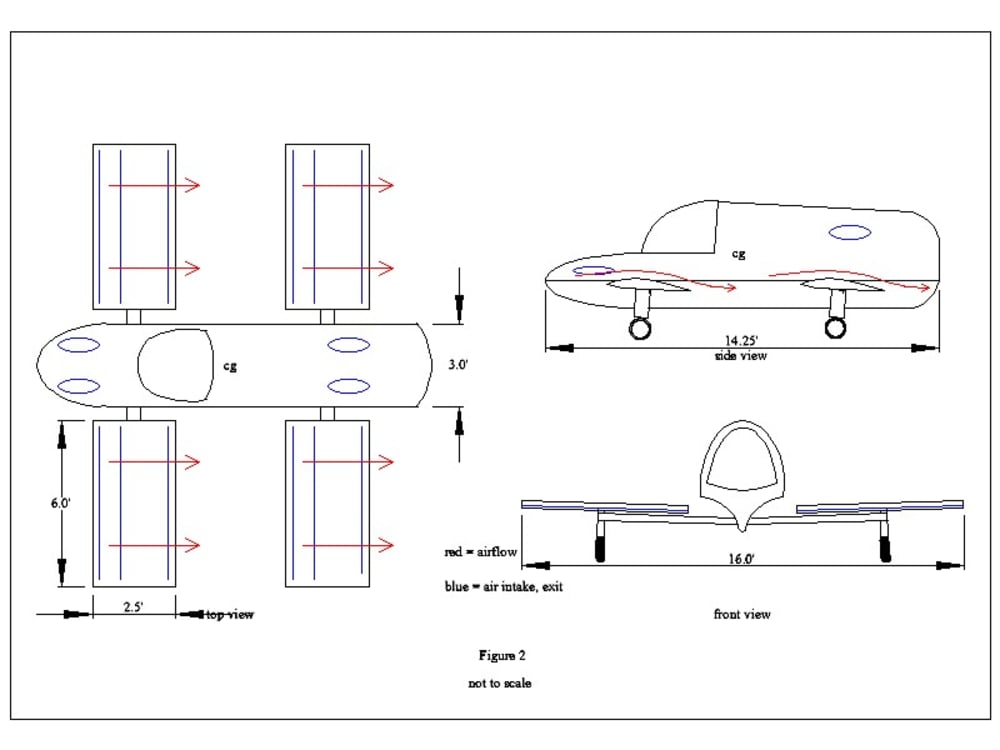Since 2018 the number of electrically powered aircraft in design has doubled to about 200, hence the name, “201.” Airbus, Boeing, Joby Aviation, Uber and others, with more than 1 billion usd in investments are designing, developing and testing the electric air vehicles of the future. In 20 years the value of eVTOL by manufacturers, operators and infrastructure providers is expected to reach 318 billion usd.
The “201” is a single person urban aerial mobility commuter vehicle (UAM) designed to alleviate traffic congestion on our freeways. It combines active flight control surfaces, uneven blown (channel) wing technology, the Bernoulli Principle, the Coanda effect, and vectored thrust with standard airfoil aerodynamics in a novel manner to achieve safe, efficient, quiet and comfortable flight. These features provide for full control of pitch, yaw or roll in either VTOL or forward flight, in either autonomous or piloted modes.
Two electrically driven fans are powered by a hydrogen/air 115KW (153hp) fuel cell, offering a 350 mile range at 100 mph cruise with a 8,000 foot ceiling and no pollution. These fans, one fore and one aft, in the plane’s fuselage, are surrounded by soundproofing foam to minimize noise and shroud all rotating parts from view and touch. A central duct, that forms the backbone of the fuselage provides strength and rigidity, and distributes the air from the fans to 4 subsidiary air ducts which are at 90 degrees to the fuselage. These subsidiary air ducts can rotate, independently or in concert, around their center of axis +/- 10 degrees to affect the winglet’s angle of attack. The winglets, independently or in concert, can rotate 150 degrees in the horizontal plane. For VTOL (Figure 1), the air exiting the winglet’s air slots (3/winglet), at 160 ft/sec provides enough pressure differential to elevate the 1000 lb vehicle, at zero forward airspeed. Secondly, this layer of high velocity air impacts the keel shaped structure of the lower fuselage rotating it 90 degrees downward, mimicking the Coanda effect and providing sufficient vertical thrust for eVTOL to be practical. Since the front and rear paired winglets oppose each other, all lateral thrust is cancelled and no horizontal movement is experienced. Transitioning to forward flight (Figure 2), all the winglets rotate to have the leading edges point forward. As this occurs, the thrust from the air slots accelerates the plane forward, while the winglet airfoil absorbs more of the load as the Coanda effect is reduced. A throttle, under computer control, in each subsidiary duct manages the airflow to each winglet to support whichever aerial maneuver is being performed.
The UAM is quick built from vacuum formed TPO with the central duct held in place via rigid, open cell foam. The fans, motors, fuel cell, cockpit etc are all mounted on the central duct before the top half of the fuselage is joined to the lower half. Winglets, subsidiary ducts, wiring harnesses, fans, motors, servos, etc. are all basically identical, and of off the shelf components. Estimated MSRP is 50K+.
Like this entry?
-
About the Entrant
- Name:Bernie Bon
- Type of entry:individual
- Software used for this entry:Turbocad, Foilsim, Office
- Patent status:pending








